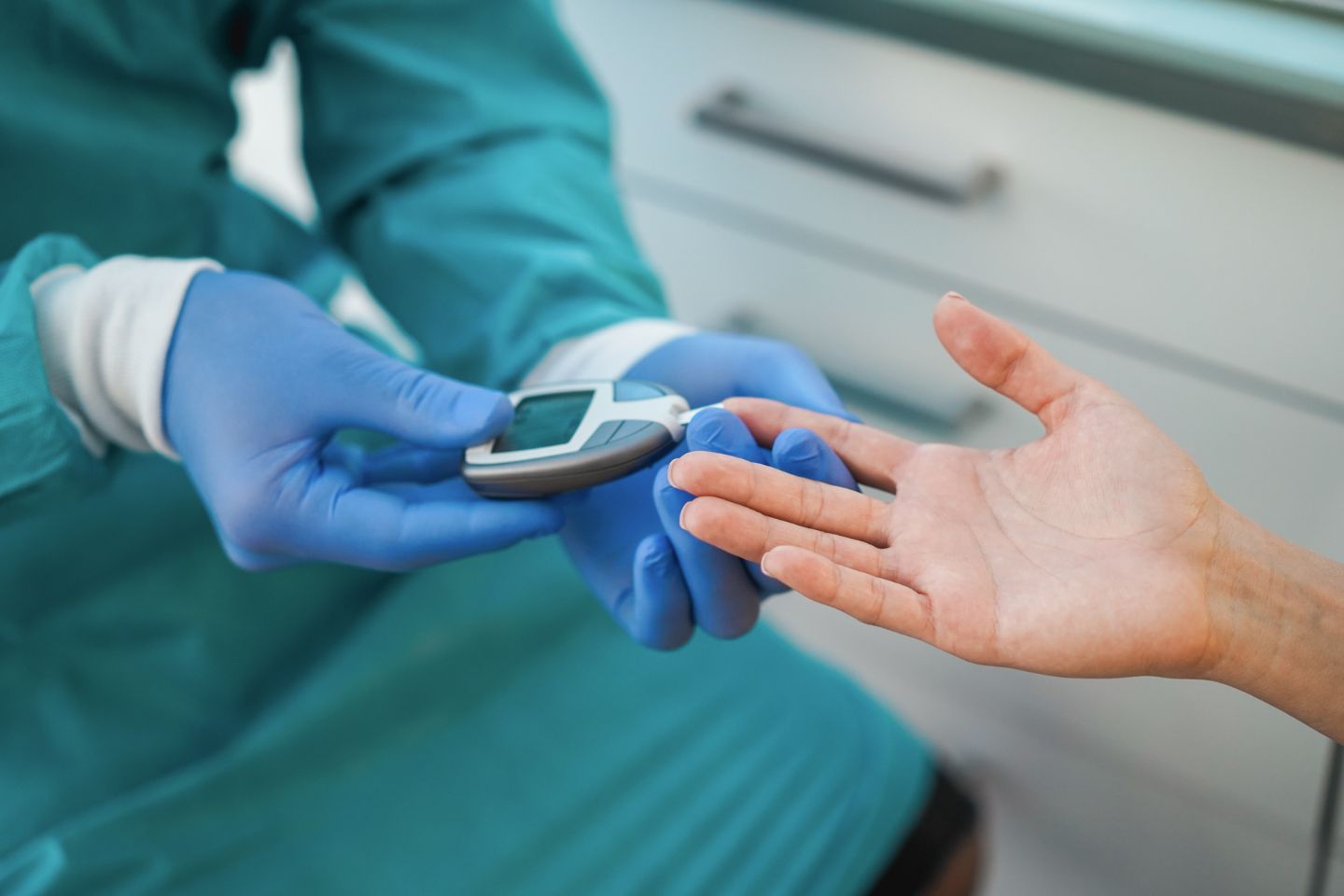
Your Quick Guide to Diabetes: Types, Causes, and Control
Introduction
Diabetes is a chronic disease that affects millions around the world. Most of us know at least one family member or friend who is affected by diabetes. According to the World Health Organization, around 422 million people are affected by this disease worldwide.
If not managed properly, diabetes can give rise to many other health complications. This article will explain what diabetes is, explain the different types of diabetes, look at some common causes and risk factors, and discuss ways to keep diabetes under control.
What is diabetes?
Diabetes is a type of illness in which an excess amount of sugar (glucose) exists in your blood. Just imagine having a key named insulin that opens the door to sugar through the cells of your body to get energy. In diabetes, either your pancreas doesn’t produce enough keys (insulin) or the keys don’t work properly to unlock your cells. As a result, sugar builds up in your blood instead of being used by your cells for energy.1
It is essential to bring diabetes under control as resulting high blood sugar levels can lead to other health conditions, some of which can be very serious. Being aware of the symptoms of diabetes can help in early diagnosis of the disease. When blood sugar is high, your body tries to get rid of the extra sugar through your urine, which makes you urinate more often and feel very thirsty. Because your cells aren't getting the energy they need (the sugar is stuck in your blood), you feel hungrier than usual. High blood sugar can also affect the tiny blood vessels in your eyes, causing blurry vision, and slow down healing because your immune system doesn't work as well when blood sugar is high.2
Other symptoms that people experience include erectile dysfunction, dry skin, and irritability.
If not managed properly, diabetes can cause a range of other health complications such as heart attack, angina, kidney failure, nerve damage, bacterial and fungal infections on the skin, retinopathy (eye damage), and depression.
What are the types of diabetes?
There are three main types of diabetes. Let’s take a look at each one –
Type 1 diabetes
In type 1 diabetes, your body's defence mechanism (immune system) becomes confused and ends up destroying the cells in your pancreas that produce insulin by mistake. The security guards guarding it are like going to kill the people working in a factory, and stop the production of insulin. This implies that type 1 diabetic patients have no alternative but to inject insulin daily to sustain their lives.3 The immune system causes damage to pancreatic cells that are responsible for making insulin.
This form of diabetes is generally diagnosed in children, though it may show up later in life. Patients diagnosed with type 1 diabetes need to take daily shots of insulin to maintain their blood sugar levels. Without these insulin injections, they cannot survive. Different types of insulin are available for human use, and the doctor will recommend the one that best suits the patient’s needs. In addition to taking insulin, it is important to follow a healthy diet and do plenty of exercise.
Studies are being conducted to find a way to either cure or delay the onset of type 1 diabetes.
Type 2 diabetes
Type 2 diabetes is comparable to having an abundance of keys (insulin) and the locks on your cells are corroded and are not opening easily. Your body retains production of insulin in your pancreas, but it does not respond appropriately to it by muscle, liver and fat cells - insulin resistance. After some time, your pancreatic muscles end up getting exhausted due to the labor and are unable to produce sufficient insulin.4 This type of diabetes is the most common one and usually develops in adulthood. However, there are some instances where children may also develop this form of diabetes.
Type 2 diabetes can be successfully managed with a healthy diet and sufficient exercise to keep one’s weight in check. Sometimes, the doctor may prescribe insulin injections or oral medicines such as metformin.
Symptoms of diabetes can often be very mild or almost non-existent for years in type 2 diabetes. Therefore, people with a family history of diabetes should get themselves tested for the condition regularly.
Gestational diabetes
During pregnancy, the placenta (which nourishes your baby) produces special hormones that are essential for your baby's growth. However, these pregnancy hormones can make it harder for your insulin to work properly - they act like putting tape over some of the locks on your cells. This usually starts around weeks 20-24 of pregnancy. Your pancreas tries to make extra insulin to overcome this problem, but sometimes it can't keep up, leading to gestational diabetes.5 Gestational diabetes is generally known to occur between the 24th and the 28th week of pregnancy.
A woman who develops gestational diabetes will not necessarily have diabetes after she gives birth. However, gestational diabetes needs to be managed well in order to avoid any possible health complications to the mother and the baby.
Gestational diabetes can affect women above the age of 25 years, women who suffer from high blood pressure and those who have cases of diabetes in their family. Women who have PCOS (polycystic ovarian syndrome) are also at a higher risk of developing gestational diabetes.
Expectant mothers who have been diagnosed with gestational diabetes may have to take insulin injections in order to keep their blood glucose levels under control.
Prediabetes
In prediabetes, a person has higher than normal levels of blood sugar or glucose. However, the levels are not high enough for a diagnosis of diabetes type 2. However, if left untreated, prediabetes can develop into diabetes type 2.
Maintaining a healthy, nutritious diet and following an active lifestyle can help prevent the progression of prediabetes into diabetes type 2.
What is diabetes caused by?
Let’s look at the causes of each type of diabetes and explore the underlying risk factors –
Type 1 diabetes
Type 1 diabetes is caused by an autoimmune condition. This means that it results from the immune system attacking healthy cells. Genetic factors play a huge role in determining a person’s risk for developing type 1 diabetes. Unhealthy eating habits and a sedentary lifestyle cannot cause type 1 diabetes.
Type 2 diabetes
Type 2 diabetes occurs when the cells in the body become insulin resistant, and the pancreas cannot make enough insulin to keep blood sugar levels in check. People who are obese are at significant risk for developing type 2 diabetes.
There are a few elements that can raise your risk of attaining Type 2 diabetes. Insulin cannot work effectively when you have extra weight, primarily in your belly. In case diabetes is a family trend, then you might have been born with the genes that predispose you to diabetes. Failure to achieve the recommended amount of physical activity implies that your muscles become inefficient in consuming glucose. Such other conditions as PCOS (cysts on the ovaries) or having had diabetes in pregnancy also put you at risk. The good news is that most of these risk factors can be bettered by lifestyle modifications.6
Gestational diabetes
When a woman is pregnant, certain hormones are made in the body to support the pregnancy. These hormones may cause insulin resistance. The pancreas tries to create more insulin to balance out this resistance; however, if this organ does not manage to do so, the expectant mother may develop gestational diabetes.
Prediabetes
The risk for developing prediabetes is higher among people who have a family history of diabetes. Being overweight, having a large waistline, having a family history of diabetes, smoking, having PCOS, and a lack of exercise can lead to prediabetes. Consuming excess sugar can also increase your risk of developing diabetes.
Diagnosis of diabetes
Blood tests can help diagnose whether a person has diabetes or not. These blood tests can diagnose type 1 diabetes, type 2 diabetes, and prediabetes. The tests that are commonly done include a fasting blood sugar test, random blood sugar test, and the glycated hemoglobin ( Hba1c) test.
Methods of managing and controlling diabetes
Diabetes is a condition that needs to be managed lifelong. Following proper methods of controlling the disease will help you live a healthy, comfortable life. Diabetes can be successfully managed through medicines and changes in lifestyle. Let’s take a look at how to control diabetes -
- Medical methods
Patients who have been diagnosed with type 1 diabetes almost always need to take insulin. Those who have type 2 diabetes may need to take insulin, depending on the severity of their condition. There are different types of insulin, such as short-acting insulin, long-acting insulin, and rapid-acting insulin. There are various devices available for administering insulin. Patients may take injections, or use an insulin pen or pump, depending on what their doctor recommends.
If you have been prescribed medicines to manage and control your diabetes, you need to always adhere to the dosage schedule given by the doctor. That is the best way to ensure that your blood sugar levels will stay in control. Skipping a dose is not recommended.
Apart from medicines, patients also need to monitor their blood sugar levels frequently. This monitoring is especially important for those who take insulin daily. They may need to test their blood sugar levels at home at least 3 to 4 times a day.
- Lifestyle methods
Diabetes can be successfully managed with the help of a healthy diet and an active lifestyle. Focus on eating foods that won't cause big spikes in your blood sugar. Choose whole grains instead of white bread or rice, eat plenty of vegetables (especially green leafy ones), and include lean proteins like fish, chicken, or beans. When you do eat fruits, pair them with protein or healthy fats to slow down sugar absorption. Think of your plate as being half vegetables, one quarter lean protein, and one quarter whole grains or starchy vegetables.7 Lean meats can act as a good source of protein. If you are unsure about what to eat in a day, you may want to consider talking to a dietician for advice on the ideal meal plan.
In addition to eating right, you also need to bring your weight under control. Make sure to get at least 30 minutes of exercise daily, if not more. Try aerobic exercises such as walking, cycling, and swimming. You can even consider choosing an exercise form that you might enjoy, such as running or dancing. Whichever form of physical activity you choose, make sure to create a plan and stick with it so you stay in shape.
Smoking is another cause that can alleviate diabetes. Try to seek professional help to stop smoking as this habit can worsen your health. Also, try to cut down on stress levels as excessive stress might worsen your health and add to existing medical complications. In addition, alcohol consumption can also result in diabetes.
Testing for diabetes with the Merilyzer GluQuantA1c diabetes machine
Meril is a global MedTech company that designs and manufactures medical devices to alleviate human suffering. The Merilyzer GluQuantA1c diabetes machine is a fully automated HbA1c analyzer that is based on Ion Exchange Chromatography with HPLC principle. HPLC is recommended by WHO and is known as the ‘gold standard’ for its high sensitivity and stability of performance. This machine can be used to measure the ratio of glycated hemoglobin in blood, fast analysis, etc.
The Merilyzer GluQuantA1c diabetes machine has user-friendly software and is extremely simple to operate.
In conclusion
At some point in the future, medical research may, perhaps, discover a cure for diabetes. Or it may even find a way to successfully prevent this condition completely. Until that point, we need to take steps to manage diabetes so that the disease does not control our lives. Following prescribed medication and leading a healthy lifestyle can go a long way in promoting overall wellbeing and quality of life when living with diabetes.
References
3 https://www.niddk.nih.gov/health-information/diabetes/overview/what-is-diabetes/type-1-diabetes
https://academic.oup.com/edrv/article/46/3/317/8042119
4 https://www.cdc.gov/diabetes/about/insulin-resistance-type-2-diabetes.html
https://pubmed.ncbi.nlm.nih.gov/39353925/
https://pmc.ncbi.nlm.nih.gov/articles/PMC6274679/
6 https://www.niddk.nih.gov/health-information/diabetes/overview/risk-factors-type-2-diabetes



